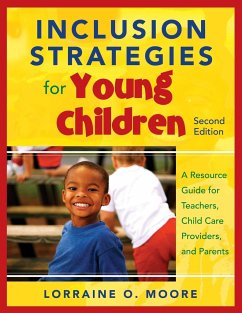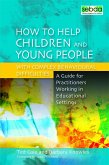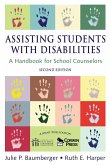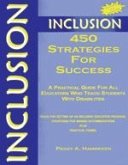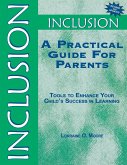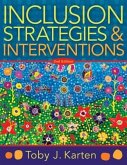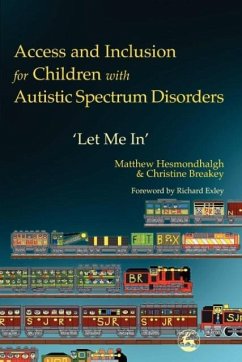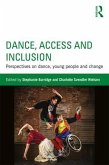Lorraine O. Moore
Inclusion Strategies for Young Children
A Resource Guide for Teachers, Child Care Providers, and Parents
Lorraine O. Moore
Inclusion Strategies for Young Children
A Resource Guide for Teachers, Child Care Providers, and Parents
- Broschiertes Buch
- Merkliste
- Auf die Merkliste
- Bewerten Bewerten
- Teilen
- Produkt teilen
- Produkterinnerung
- Produkterinnerung
Concrete methods for enhancing young children's growth and development! This user-friendly book, written for educators who work with 3- to7-year-olds, provides more than 350 strategies to promote success for beginning learners, especially those with special needs. The second edition contains current brain research about learning and behavior challenges, updated information on IDEA 2004, a glossary, resource listings of organizations, and reproducibles. The author provides teachers with developmentally appropriate practices to help children: Increase motor skills Develop emotionally and…mehr
Andere Kunden interessierten sich auch für
![How to Help Children and Young People with Complex Behavioural Difficulties How to Help Children and Young People with Complex Behavioural Difficulties]() Barbara KnowlesHow to Help Children and Young People with Complex Behavioural Difficulties39,99 €
Barbara KnowlesHow to Help Children and Young People with Complex Behavioural Difficulties39,99 €![Assisting Students with Disabilities Assisting Students with Disabilities]() Julie P. BaumbergerAssisting Students with Disabilities33,99 €
Julie P. BaumbergerAssisting Students with Disabilities33,99 €![Inclusion Inclusion]() Peggy A. HammekenInclusion41,99 €
Peggy A. HammekenInclusion41,99 €![Inclusion Inclusion]() Lorraine O. MooreInclusion40,99 €
Lorraine O. MooreInclusion40,99 €![Inclusion Strategies and Interventions, Second Edition Inclusion Strategies and Interventions, Second Edition]() Toby J KartenInclusion Strategies and Interventions, Second Edition37,99 €
Toby J KartenInclusion Strategies and Interventions, Second Edition37,99 €![Access and Inclusion for Children with Autistic Spectrum Disorders Access and Inclusion for Children with Autistic Spectrum Disorders]() Matthew HesmondhalghAccess and Inclusion for Children with Autistic Spectrum Disorders43,99 €
Matthew HesmondhalghAccess and Inclusion for Children with Autistic Spectrum Disorders43,99 €![Dance, Access and Inclusion Dance, Access and Inclusion]() Dance, Access and Inclusion73,99 €
Dance, Access and Inclusion73,99 €-
-
-
Concrete methods for enhancing young children's growth and development! This user-friendly book, written for educators who work with 3- to7-year-olds, provides more than 350 strategies to promote success for beginning learners, especially those with special needs. The second edition contains current brain research about learning and behavior challenges, updated information on IDEA 2004, a glossary, resource listings of organizations, and reproducibles. The author provides teachers with developmentally appropriate practices to help children: Increase motor skills Develop emotionally and socially Acquire better communication, listening, and attention skills Work toward self-management of behaviors Develop preparatory reading, writing, and math skills
Hinweis: Dieser Artikel kann nur an eine deutsche Lieferadresse ausgeliefert werden.
Hinweis: Dieser Artikel kann nur an eine deutsche Lieferadresse ausgeliefert werden.
Produktdetails
- Produktdetails
- Verlag: Corwin
- 2. Auflage
- Seitenzahl: 152
- Erscheinungstermin: 19. Februar 2009
- Englisch
- Abmessung: 280mm x 216mm x 8mm
- Gewicht: 402g
- ISBN-13: 9781412971089
- ISBN-10: 141297108X
- Artikelnr.: 25553469
- Herstellerkennzeichnung
- Libri GmbH
- Europaallee 1
- 36244 Bad Hersfeld
- gpsr@libri.de
- Verlag: Corwin
- 2. Auflage
- Seitenzahl: 152
- Erscheinungstermin: 19. Februar 2009
- Englisch
- Abmessung: 280mm x 216mm x 8mm
- Gewicht: 402g
- ISBN-13: 9781412971089
- ISBN-10: 141297108X
- Artikelnr.: 25553469
- Herstellerkennzeichnung
- Libri GmbH
- Europaallee 1
- 36244 Bad Hersfeld
- gpsr@libri.de
Lorraine O. Moore has taught at the elementary and middle school levels, was a counselor in a middle school and high school, and was a school psychologist at all levels in both public and private schools. Moore was an instructor and adjunct associate professor in the counseling and psychology graduate education programs at the University of St. Thomas (St. Paul, MN) and at St. Mary's College Graduate Center in Minneapolis, MN. She has an extensive background in child development and is strongly committed to helping create more peaceful and fulfilling environments for children within a global context. She is the author of the books Inclusion Strategies for Young Children; Inclusion: A Practical Guide for Parents; Learning, What It Is-How Parents Can Help; Creating Balance in Children's Lives; and, Creating Balance in Children. Moore is a coauthor of the Whole Kid Peace Activity Book. She earned her doctorate in educational psychology.
Preface Acknowledgments About the Author Introduction 1. Working With Young Children Major Findings From Brain Research "Whole Child" Perspective Developmentally Appropriate Practice Cycles of Learning Phase I: Awareness Phase II: Exploration Phase III: Inquiry Phase IV: Utilization or Application Environmental Considerations Testing and Labeling of Young Children Working With Parents Teaching From the Heart 2. Inclusion: The Right to Equal Educational Experiences Children With Special Needs Types of Special Needs Labeling of Young Children Legislation That Supports Inclusion Inclusion Benefits of Inclusive Education Barriers to Inclusive Education Summary 3. General Strategies for Working With Young Children Expectations Time Environmental Conditions Nutrition and Learning Multi-Sensory Activities Basic Categories of Modification Brain Balancing 4. Communication Strategies Basic Communication Strategies Attending Strategies Listening Strategies Attaching Meaning to Print and Words Strategies for Children With a Hearing Impairment Strategies for Children With a Visual Impairment Strategies and Information for Children With Limited Speech and Expressive Language 5. Large and Small Motor Development Strategies for Large Motor Development Strategies for Small Motor Development 6. Emotional/Social Development Strategies for Supporting Emotional Development Strategies for Supporting Social Development 7. Guiding and Modifying Children
s Behavior General Strategies for Guiding Children
s Behavior Strategies for Modifying Children
s Behavior Strategies for Children With Attention Problems Strategies for Aggressive and Withdrawn Behaviors Strategies for Problem Solving 8. Preparatory Writing, Reading, and Math Skills Preparatory Writing and Reading Skills Preparatory Math Skills 9. Assessing Young Children Characteristics of Young Children That Affect Assessment Developmental Patterns Purposes for Assessing Young Children Assessment Tools and Techniques Observation Interviews Standardized Tests Other Assessment Procedures Assessment of Children With Special Needs Summary 10. Learning in the 21st Century Brain Research Nutrition and Learning Other Needs of the Brain and Body Environmental Factors and Learning Expanded View of Intelligence Responsibility Appendix A: Forms and Activities Form 1: Profile of Development Form 2: Cycles of Learning Form 3: Behavior as a Function of the Interaction of the Child in His Environment Form 4: General Strategies for Working With Young Children Form 5: Categories of Modifications Form 6: Creating a Personal Dictionary of Familiar Objects Form 7: Mazes Form 8: Learning About Feelings Through Working With Animals Form 9: Sharing and Talking About Feelings Form 10: Learning About Feelings Through Dramatic Play Form 11: Learning About Empathy Form 12: Settling Conflicts Peacefully Form 13: Steps for Problem Solving Form 14: Steps in Changing Behaviors Form 15: Charting Frequency of Behaviors Form 16: Child Observation Form Form 17: Examples of Observation Forms Form 18: Interview About the Child Appendix B: Bibliography Appendix C: Resources Appendix D: Glossary Index
s Behavior General Strategies for Guiding Children
s Behavior Strategies for Modifying Children
s Behavior Strategies for Children With Attention Problems Strategies for Aggressive and Withdrawn Behaviors Strategies for Problem Solving 8. Preparatory Writing, Reading, and Math Skills Preparatory Writing and Reading Skills Preparatory Math Skills 9. Assessing Young Children Characteristics of Young Children That Affect Assessment Developmental Patterns Purposes for Assessing Young Children Assessment Tools and Techniques Observation Interviews Standardized Tests Other Assessment Procedures Assessment of Children With Special Needs Summary 10. Learning in the 21st Century Brain Research Nutrition and Learning Other Needs of the Brain and Body Environmental Factors and Learning Expanded View of Intelligence Responsibility Appendix A: Forms and Activities Form 1: Profile of Development Form 2: Cycles of Learning Form 3: Behavior as a Function of the Interaction of the Child in His Environment Form 4: General Strategies for Working With Young Children Form 5: Categories of Modifications Form 6: Creating a Personal Dictionary of Familiar Objects Form 7: Mazes Form 8: Learning About Feelings Through Working With Animals Form 9: Sharing and Talking About Feelings Form 10: Learning About Feelings Through Dramatic Play Form 11: Learning About Empathy Form 12: Settling Conflicts Peacefully Form 13: Steps for Problem Solving Form 14: Steps in Changing Behaviors Form 15: Charting Frequency of Behaviors Form 16: Child Observation Form Form 17: Examples of Observation Forms Form 18: Interview About the Child Appendix B: Bibliography Appendix C: Resources Appendix D: Glossary Index
Preface Acknowledgments About the Author Introduction 1. Working With Young Children Major Findings From Brain Research "Whole Child" Perspective Developmentally Appropriate Practice Cycles of Learning Phase I: Awareness Phase II: Exploration Phase III: Inquiry Phase IV: Utilization or Application Environmental Considerations Testing and Labeling of Young Children Working With Parents Teaching From the Heart 2. Inclusion: The Right to Equal Educational Experiences Children With Special Needs Types of Special Needs Labeling of Young Children Legislation That Supports Inclusion Inclusion Benefits of Inclusive Education Barriers to Inclusive Education Summary 3. General Strategies for Working With Young Children Expectations Time Environmental Conditions Nutrition and Learning Multi-Sensory Activities Basic Categories of Modification Brain Balancing 4. Communication Strategies Basic Communication Strategies Attending Strategies Listening Strategies Attaching Meaning to Print and Words Strategies for Children With a Hearing Impairment Strategies for Children With a Visual Impairment Strategies and Information for Children With Limited Speech and Expressive Language 5. Large and Small Motor Development Strategies for Large Motor Development Strategies for Small Motor Development 6. Emotional/Social Development Strategies for Supporting Emotional Development Strategies for Supporting Social Development 7. Guiding and Modifying Children
s Behavior General Strategies for Guiding Children
s Behavior Strategies for Modifying Children
s Behavior Strategies for Children With Attention Problems Strategies for Aggressive and Withdrawn Behaviors Strategies for Problem Solving 8. Preparatory Writing, Reading, and Math Skills Preparatory Writing and Reading Skills Preparatory Math Skills 9. Assessing Young Children Characteristics of Young Children That Affect Assessment Developmental Patterns Purposes for Assessing Young Children Assessment Tools and Techniques Observation Interviews Standardized Tests Other Assessment Procedures Assessment of Children With Special Needs Summary 10. Learning in the 21st Century Brain Research Nutrition and Learning Other Needs of the Brain and Body Environmental Factors and Learning Expanded View of Intelligence Responsibility Appendix A: Forms and Activities Form 1: Profile of Development Form 2: Cycles of Learning Form 3: Behavior as a Function of the Interaction of the Child in His Environment Form 4: General Strategies for Working With Young Children Form 5: Categories of Modifications Form 6: Creating a Personal Dictionary of Familiar Objects Form 7: Mazes Form 8: Learning About Feelings Through Working With Animals Form 9: Sharing and Talking About Feelings Form 10: Learning About Feelings Through Dramatic Play Form 11: Learning About Empathy Form 12: Settling Conflicts Peacefully Form 13: Steps for Problem Solving Form 14: Steps in Changing Behaviors Form 15: Charting Frequency of Behaviors Form 16: Child Observation Form Form 17: Examples of Observation Forms Form 18: Interview About the Child Appendix B: Bibliography Appendix C: Resources Appendix D: Glossary Index
s Behavior General Strategies for Guiding Children
s Behavior Strategies for Modifying Children
s Behavior Strategies for Children With Attention Problems Strategies for Aggressive and Withdrawn Behaviors Strategies for Problem Solving 8. Preparatory Writing, Reading, and Math Skills Preparatory Writing and Reading Skills Preparatory Math Skills 9. Assessing Young Children Characteristics of Young Children That Affect Assessment Developmental Patterns Purposes for Assessing Young Children Assessment Tools and Techniques Observation Interviews Standardized Tests Other Assessment Procedures Assessment of Children With Special Needs Summary 10. Learning in the 21st Century Brain Research Nutrition and Learning Other Needs of the Brain and Body Environmental Factors and Learning Expanded View of Intelligence Responsibility Appendix A: Forms and Activities Form 1: Profile of Development Form 2: Cycles of Learning Form 3: Behavior as a Function of the Interaction of the Child in His Environment Form 4: General Strategies for Working With Young Children Form 5: Categories of Modifications Form 6: Creating a Personal Dictionary of Familiar Objects Form 7: Mazes Form 8: Learning About Feelings Through Working With Animals Form 9: Sharing and Talking About Feelings Form 10: Learning About Feelings Through Dramatic Play Form 11: Learning About Empathy Form 12: Settling Conflicts Peacefully Form 13: Steps for Problem Solving Form 14: Steps in Changing Behaviors Form 15: Charting Frequency of Behaviors Form 16: Child Observation Form Form 17: Examples of Observation Forms Form 18: Interview About the Child Appendix B: Bibliography Appendix C: Resources Appendix D: Glossary Index

